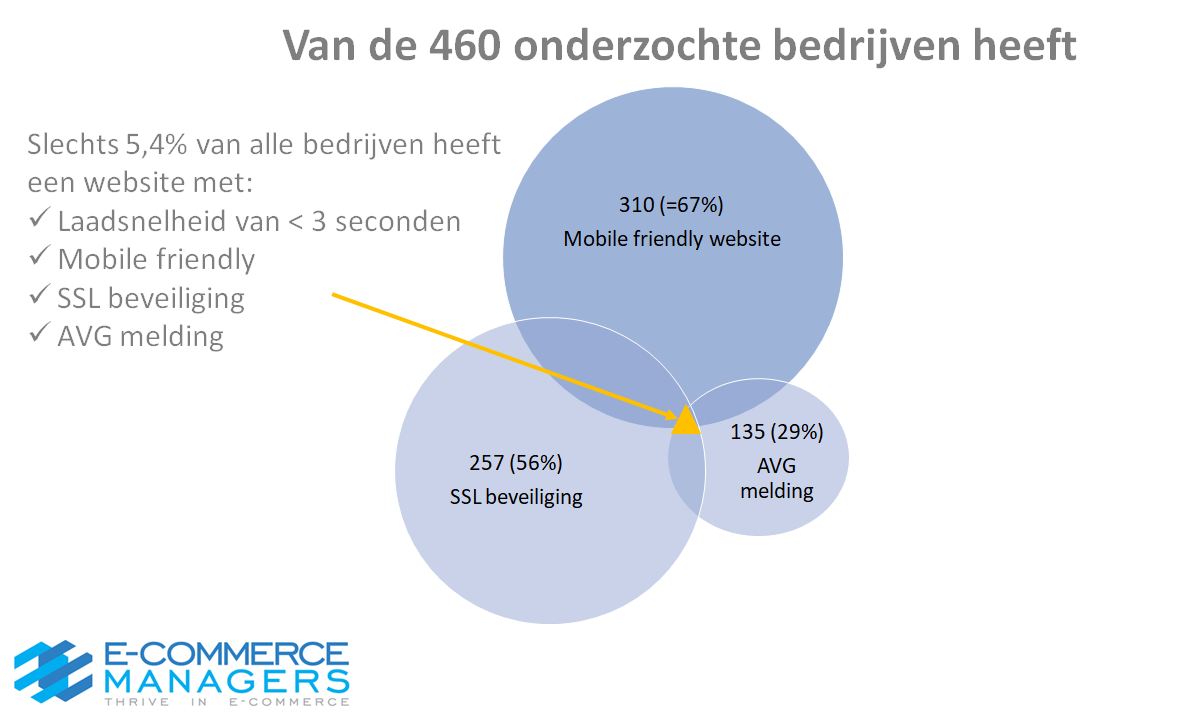Bedrijven uit Zwolle en Deventer scoren ondermaats v.w.b. basis online aanwezigheid
/in Business, Campaigning, Funnel optimization, Local, Web 2.0./door Joost HoogstrateBegin augustus was ik in gesprek met een ondernemer uit Deventer die mij vroeg waar een moderne website aan moet voldoen. Na het gesprek was ik benieuwd hoe het met organisaties in de regio staat en besloot een klein onderzoek te doen onder 761 bedrijven uit Zwolle en Deventer.
Achtergrond onderzoek
In de omgeving van Zwolle en Deventer heb ik onderzocht hoe het met de online aanwezigheid van bedrijven gaat. De bedrijven die ik bekeken heb, zitten in alle branches, zijn commercieel/economisch actief en hebben tussen de 10-100 man personeel. De bedrijven zijn onderzocht op een viertal criteria die essentieel zijn voor een goede website:
- De veiligheid van de website (is er een SSL certificaat);
- Is de website mobile friendly;
- Heeft de website een AVG cookie-melding;
- Hoe is de laadsnelheid van de website.
Doel
Omdat een website het eerste is wat bezoekers en klanten zien van een bedrijf, is het hebben van een goed functionerende website essentieel. De vier criteria vormen tezamen een minimum voor de huidige eisen aan de online aanwezigheid van bedrijven, een website zorgt ervoor dat je klanten aantrekt, ze weten wat je aanbiedt en kan wanneer deze goed ingericht is ervoor zorgen dat je goed verkoopt.
Uitkomsten onderzoek
Het onderzoek toont aan dat 60% van de 761 bedrijven (460 organisaties) de URL(www. etc) van het bedrijf geregistreerd heeft bij de Kamer van Koophandel. Voor 40% van de bedrijven betekent dit dus dat zij online minder goed aanwezig zijn. Door de registratie van de URL bij de Kamer van Koophandel komt er meer verkeer naar een website van een bedrijf en krijgt deze hogere positie in zoekmachines. Omdat deze 460 bedrijven een geregistreerde website hebben, zijn deze websites verder onderzocht op de andere drie criteria.
Mobile friendly
Van alle bedrijven is een derde van de websites niet goed te bezoeken op een smartphone. Op dit moment komt 63% van al het websiteverkeer via een smartphone. Het hebben van een mobile friendly website is essentieel bij de vindbaarheid van een website. Google geeft sinds april 2018 een speciale mobile first index, die aangeeft of een website toegankelijk is met een smartphone.
Zelf checken of je website mobile-friendly is?
Veilige website
De veiligheid van de websites is onderzocht, slechts 257 bedrijven (56%) heeft een SSL verbinding. De 203 bedrijven die geen SSL hebben zullen veel bezoekers missen doordat zij nog steeds gebruik maken van een onveilige verbinding. Een van de grootste zoekmachines – Google Chrome (marktaandeel circa 75%) – heeft sinds september 2018 een melding die aangeeft of de websites veilig is (een SSL verbinding heeft) middels een groen slotje. Naast veiligheid biedt SSL andere voordelen zoals een snellere laadsnelheid, voldoen aan de AVG en een professionele uitstraling naar website bezoekers en klanten.
Zelf checken hoe veilig je website is?
AVG proof
Om aan de AVG te kunnen voldoen moeten websites wanneer zij cookies plaatsen een melding hiervan maken, tenzij het functionele cookies betreft. Slechts 135 (29%) van de 460 onderzochte websites had een AVG Cookiebar. Van de 325 websites die géén cookiebar hebben, hadden 183 (52%) websites het wél moeten hebben. Waarmee deze sites dus niet voldoen aan de AVG.
Zelf controleren welke cookies je website gebruikt?
- http://www.cookiechecker.nl/
Snelle website
Het vijfde criterium waar onderzoek naar gedaan is, is de laadsnelheid van de website. Gemiddeld was deze bij de 460 onderzochte URL’s 6,2 seconden. De gewenste snelheid van een websites, is maximaal 3 seconden, omdat smartphone gebruikers zéér snel weg gaan, conversiepercentages omlaag gaan door trage laadsnelheden en posities in de zoekmachines ook beïnvloed worden door de laadsnelheid. 109 bedrijven hadden de gewenste laadsnelheid van 3 seconden of sneller.
Zelf de snelheid van je website controleren?
- https://www.webpagetest.org/
- https://gtmetrix.com/
- https://developers.google.com/speed/pagespeed/insights/
Top websites
Welke bedrijven konden voldoen aan de vier gestelde criteria? Met andere woorden hoeveel procent van de bedrijven uit Zwolle en Deventer hebben essentiële onderdelen van hun online aanwezigheid goed voor elkaar? Slechts 5,4% van de 460 onderzochte bedrijven uit Zwolle en Deventer hebben dit op orde. Of zij ook hun online marketing op orde hebben, is niet nader bekeken.

Conclusie
Dit onderzoek heeft vooral gekeken naar de minimale eisen die aan een hedendaagse website worden gesteld. Het is bedroevend dat een percentage van 5% van de bedrijven uit Zwolle en Deventer hieraan voldoet. Ondanks dat niet alle bedrijven in de regio onderzocht zijn, geeft het wel aan dat ondernemer omzetmogelijkheden verliezen door het niet hebben van een goede online aanwezigheid. Voor een relatief geringe investering kan een prima functionerende website neergezet worden met de meeste geavanceerde online marketing technologie.
Werk aan de winkel!
Over ons
E-commercemanagers.com heeft als missie om bedrijven en organisaties succesvoller te laten zijn in het digitaal geautomatiseerde tijdperk.
Wij geloven dat analyse en inzicht in de oorzaken van vraagstukken cruciaal zijn vervolgens oplossingen te implementeren die efficient, effectief en schaalbaar zijn.
Data, automatisering en personalisatie hebben daar in de meeste gevallen een belangrijke rol in.
Wij werken op een agile wijze met scrum technieken en proberen snel tot de kern te komen.
Inschrijven nieuwsbrief
Schrijf u nu in voor de maandelijkse nieuwsbrief:
Laatste nieuws
- Nieuwe CO2 calculator voor e-commerce bedrijven, webwinkels en webshops 4 juni 2024
- Google SEO lek 31 mei 2024
- Groei Nederlandse startups en scale-ups vertraagd 27 mei 2024
- Groei marketing bureau’s grotendeels ten einde 15 mei 2024
- European Accessibility Act (EAA) 20 april 2024
Algemeen
Contactgegevens
E-commercemanagers.com
⛾ Goudenregen 12
8141 XA HEINO
☎ 038-2340222
✉ info [at] e-commercemanagers.com

